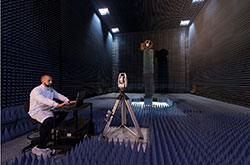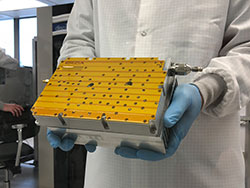
Figure 4 Tryo Group has facilities for the design and qualification of antennas and RF equipment for both broadcast and space applications.
Particle Accelerator Components
Tryo Group is a Spanish-headquartered RF and microwave specialist, consisting of two divisions—Tryo Aerospace and RYMSA RF—and has facilities in Madrid as well as in other cities including Bilbao and Barcelona, along with international offices. Figure 4 shows an anechoic chamber, part of Tryo Group’s facilities for the design and qualification of antennas and RF equipment for both broadcast and space applications. Tryo Aerospace designs and manufactures antennas and subsystems, while the product portfolio of RYMSA RF includes antennas, filters, combiners and air traffic control systems.
In recent months, RYMSA has secured contracts with two important European scientific organizations for components for particle accelerators. In May, the European Organization for Nuclear Research (CERN) selected RYMSA as its sole supplier for the manufacturing, integration and cabling of 2,752 sets of output filters and high frequency transformers for the proposed upgrading of the modular converter R2E-LHC, which is a key component of the Large Hadron Collider.
In a similar application, the GSI Helmholtz Center for Heavy Ion Research (GSI) in Germany selected RYMSA for the supply of several 9 3/16 EIA directional couplers and coaxial parts for the RF powerlines of GSI/FAIR Proton LINAC (linear accelerator) project. The seven RF powerlines each feed the RFQ cavity with 2.5 MW of forward power and a maximum of 5.5 MW of reflected power at a frequency of 352 MHz.
In June of this year it was announced that Tryo Group had been acquired by Sener, a Spanish engineering and construction group with a division specializing in aerospace. The merger brings together aerospace businesses with a combined turnover of almost €120 million.
Unmanned Vehicles, Airborne and Underwater
Indra Sistemas is a Spanish multi-national IT and defense systems company headquartered in Madrid. With a broad portfolio in developing end-to-end technology in fields such as defense and security, transportation, energy, telecommunications and media and healthcare, the company has a total turnover of more than €3,000 million.
Indra is particularly active in air-traffic control systems and radar and the company will exhibit at EuMW 2018. Miguel Acitores, Indra’s director of security business development, will speak in the Defence, Security & Space Forum on Wednesday, 26 September on the topic of anti-UAV defense systems. Indra speakers will be featured in both the opening and closing sessions of EuRAD: Maria Carmen Barbero, head of naval radar programs, will present the new radar generation for the F-110 frigate integrated masts, focusing specifically on the advances made in the development of the primary S- and X-Band radar, secondary radar and other sensors. Jacobo Martínez-Villa will describe the S3T Spanish ESA radar facility for space debris surveillance that is just starting to be installed. There will also be a speaker from Indra in the EuMW Career Platform session on Tuesday, 25 September.
TTI has its headquarters in Santander on the North coast of Spain, supported by additional facilities in Madrid and Seville. It specializes in designing and developing customized antennas ranging in frequency from L- up to Ka-Band. These include printed antennas for linear and circular polarizations, active phase array antennas and waveguide and horn antennas, many of which are aimed at SATCOM applications. Complete hybrid systems in X-, Ku- and Ka-Bands are also produced for “on-the-move” SATCOMs.
TTI is a member of the EU SWARMs consortium, for the robotic remote control and operation of unmanned underwater and surface vehicles. Final integration and validation were performed for the European Commission at Trondheim in Norway during June of this year. These final tests demonstrated the performance of integrated acoustic and radio communications networks for two autonomous underwater vehicles (AUV) and a unmanned surface vehicle (USV), including both remote control of the USV and the execution of specific AUV missions controlled from the onshore command and control center.
Amplifiers
ERZIA, which has its headquarters in Santander, makes microwave and mmWave modular high-power and low-noise amplifiers, and also integrated subsystems, operating up to over 100 GHz. Its portfolio includes a range of standard amplifier modules, as well as offering customization for both amplifiers and high-specification integrated assemblies for aerospace, commercial, military and scientific systems.
Applications have included electronic warfare (EW) systems for a number of European defense system main integrators for land, air and naval platforms, and space-qualified amplifiers and systems have been supplied for missions such as LISA Pathfinder, Change 3 and 4, SEOSAR PAZ, Exomars and Venus Express. Another product line is long-range line-of-sight datalink systems for unmanned aerial vehicles (UAV) and combat aircraft, which has been flight qualified on F-16 fighters.

Figure 5 200 W X-Band pulsed SSPA for radar applications, being launched by ERZIA at EuMW 2018.
ERZIA will introduce at EuMW 2018 its latest product line of X-Band pulsed solid-state power amplifiers (SSPA) for radar applications. Based on GaN devices, the new SSPAs have output powers of 50, 100, 200 (see Figure 5) and 400 W, and are part of a range that already included CW SSPAs and space-qualified amplifiers at X-Band. The company will also give a presentation at the MicroApps seminar about its high-power X-Band amplifier design work.
Antennas
Barcelona-based Fractus Antennas SL designs, manufactures and commercializes miniature, off-the-shelf antennas for smartphones, short-range wireless and connected IoT devices. Founded as an independent antenna product business in 2015, Fractus Antennas was born out of the main Fractus operation, and combines a respected R&D team with proven manufacturing capabilities and scale to bring to market a new generation of antenna products to meet the mobile and wireless connectivity needs of OEMs. Fractus Antennas’ most recent launch was a new reference design that explains how to use the TRIO mXTEND™ chip antenna component to get the GNSS and Mobile frequency bands at the same time. TRIO mXTEND™ is the newest member of the Virtual Antenna™ family and it is also the only one with a multiport configuration.
Research Centers
The industrial and manufacturing base in Spain is supported by an active research base, both in universities and research institutions, many of which are involved in a number of EU-sponsored R&D programs.
The Universidad Politécnica de Madrid (UPM, Polytechnic University of Madrid) is the highest-ranked technical university in Spain, and, as well as its degree programs, it is very active in a number of EU projects in telecoms and microwave technology. Naturally, as the event is taking place this year in its home city, UPM has a number of representatives on the EuMW 2018 Organizing Committee.
Ceit-IK4 is a non-profit research center that was set up in 1982 by the University of Navarra with a mission to work closely with the R&D departments of industrial clients to carry out applied research projects. It also has an academic role in training doctoral students within the framework of industrial research projects, and in publishing and disseminating non-confidential results. One of its projects is the IoTSpace initiative, an open laboratory to promote training and innovation in young researchers working on real-life projects related to the IoT.
25 Years On
For an overview of the microwave industry in Spain, and how it has changed over the past 25 years, I spoke with Michael Chadwick of SpanTech, a specialist distributor of microwave components that was first launched onto the market at the 23rd EuMC in Madrid in 1993, and will celebrate its 25th anniversary by exhibiting at this year’s event.
“The RF and microwave industry in Spain has changed beyond all recognition since 1993, when there was a limited market here, mostly for standard components. Now Spain is challenging the market in integrated systems as well as exporting leading-edge microwave components,” said Chadwick.
In conclusion, the RF, microwave and mmWave market in Spain seems particularly buoyant at the moment, fueled by a growing level of European and global investment in satellite technology, which is one of Spain’s traditional areas of excellence. In contrast to the 1993 exhibition, which was a small and somewhat niche event, the breadth of technology expected to be on show at EuMW 2018 reflects how much this core microwave expertise has spun out into telecoms and wireless. This has positioned Spain among the leaders in developing 5G technology, as well as retaining its status in aerospace and defense applications.
| Company | EuMW Stand # |
| 5TONIC | Stand 284 |
| Indra | Stand 16 |
| TTI | Stand 248 |
| Airbus DS- CASA Espacio |
Stand 141 |
| ERZIA | Stand 12 |
| Tryo | Stand 214 |
| Spantech | Stand 335 |
Reference
